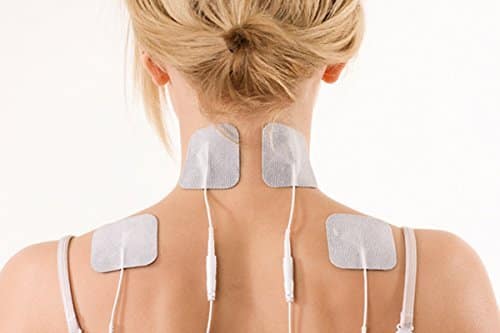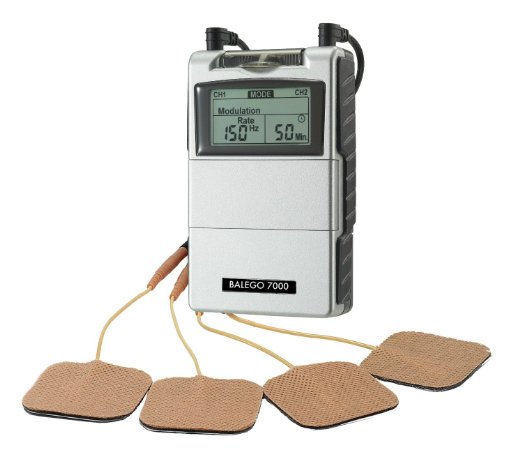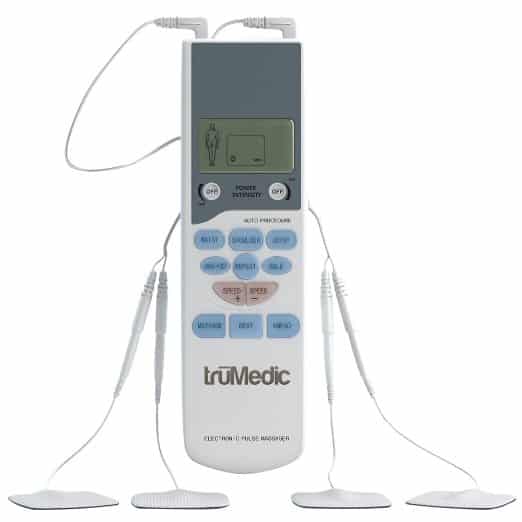TENS machines are simple to use. If it’s your first time using one however you’re right to look into all the TENS unit settings to make sure you fully understand how to use the device properly.
There are various different models on the market, and this article is designed to serve as a guide to how they typically work. Please remember that some individual devices will have different settings and uses, you should always check out the respective manual.
Contents
TENS, EMS, STIM eBook Showing Placements and Trigger Points
Before I explain some of the basics and give you some background on TENS machines and what their settings means. If you want a detailed Kindle book on the subject check out this one on Amazon as it’s the best I could find:
![]()
What is a TENS Machine?
A TENS machine is a Transcutaneous Electrical Nerve Stimulation device. It works by using mild electrical currents to relieve pain. You attach small pads to the area of your body where the pain is and they stick to the skin.
When you turn the machine on it sends electrical impulses to the area. You will feel a little tingling sensation. These sensations are signals going through the spine and to the brain. Patients feel a reduction in pain through the brain releasing hormones like endorphins, natural painkillers, and feel-good hormones.
How Tens Units Help with Back Pain
Tens units have been used since the 1960’s and to date are still commonly used to treat back pain. Users have varying results, some people find great relief in using them, while others only experience moderate differences.
Commonly treated conditions include:
- Back pain
- Neck pain
- Muscle pain
- Chronic pain
- Injuries
It’s important to remember that TENS machines only offer short-term pain relief. They are not curing the conditions or repairing damaged muscles, tendons etc. It’s a tool for pain relief.
Doctors and physiotherapists do recommend the use of a TENS machine sometimes depending on the patient. You can also choose to buy a TENS machine without being recommended or referred. Which is why understanding the TENS unit settings is incredibly important.
TENS Unit Settings and Guidelines
TENS use is noninvasive. You can use the device to relieve pain by using the pads provided as part of the product on the surface of the skin.
Different Modes
There are typically three different modes in the settings of a TENS unit.
Normal – this setting gives a constant stimulation. It’s most commonly used to help relieve acute pain and is usually the first mode you would try with the unit.
Burst – this sets the TENS unit to send bursts of power to relieve stronger pain. People who live in chronic pain will often use this setting when the pain is at its worst.
Modulation – this setting gives off a variation of frequencies. They are cyclical and help to reduce pain by shocking the nerves and is used to treat acute pain as well as lessen the strength of chronic pain.
You will also have control over the rate of the pulse and the strength of the frequency. The pulse is the amount of electrical pulses being sent per second. While the frequency is the amount of Hertz being produced.
TENS Settings for Hertz and Frequency
The following settings for pain relief in hertz are recommended as follows:
Acute Pain – 80 – 120Hz.
Moderate Pain – 35 – 50Hz.
Chronic Pain – 2 – 10Hz.
The 2 – 10Hz that’s recommended for chronic pain relief will stimulate endorphin production from your brain. While the 35 – 50Hz range is typically used to relax and strengthen muscles.
Pulse Width Settings
You can control the width of the pulse, which are the periods that the current is being sent. Most people find relief from pain with low to moderate pulse widths. While longer widths are used to contract muscles and stimulate blood circulation.
The settings are measured in microseconds. This is a fraction of a second, and while this is unnoticeable to the eye you will feel the effects when making changes to the timing.
How Long Should You Use a TENS Unit For?
There are some guidelines for how long to use a TENS machine. These are as follows:
Acute Pain – 30 – 60-minute sessions for up to 4 times a day.
Chronic Pain – 15 – 30-minute sessions for up to 5 times a week.
You shouldn’t use the machines for longer than these periods. If you are still in a lot of pain you should consult with a medical professional and act on their advice.
How to Use TENS Electrodes
The TENS machine works by attaching electrodes to your skin. These electrodes are self-adhesive and will gently stick to the area of your skin you choose. You will usually place them on the area where you are experiencing pain unless otherwise advised by a healthcare professional.
Clean the area of the skin before and after using an electrode. Rubbing alcohol or another disinfectant that you know you’re not allergic to will do. If the electrodes are not self-adhesive you can use medical tape to keep them attached to your skin.
Contraindications and Other Considerations When Using a TENS Machine Electrodes
- Never place an electrode on or around your eyes.
- Never place electrodes on the front of the neck.
- Never place electrodes on open sores or wounds.
- Never attempt to use electrodes internally.
- Do not use them over internal medical devices such as pacemakers.
TENS Machine General Guide for Use
If you do not have time to read all of the above. Or just want a checklist of some general guidelines, here are some points to keep in mind when using a TENS machine.
- Most TENS machines are designed to be small and portable. You can use them while moving around too. Look for models with belt buckles or some way to attach it to your clothing. Just be careful not to put stress on the wires from the electrodes.
- Always make sure the machine is switched off when placing the electrodes on your skin.
- You can test the machine in between your fingers before placing it on the skin if you want to be sure it’s working.
- Always clean the skin before and after using the electrodes. Follow the guidelines above and use healthy skin. If you feel any kind of reaction to the electrodes stop immediately and seek medical advice.
- If the electrodes feel like they are moving use a little medical tape to keep them securely in place.
- Use the guide above to set an appropriate pulse rate and other TENS unit settings that will be suitable to your needs.
- When you have finished always turn off the unit before removing the electrodes and then carefully peel them off.
- Store the unit in its box or another carrying case where it will be safe, dry and till not get damaged.
Image Credits: Amazon

I’m a MA, (CMT) Certified Massage Therapist, Licensed Massage Therapist (LMT), and Reiki Master — I’m a licensed massage therapist with over 10 years of experience in the industry.




